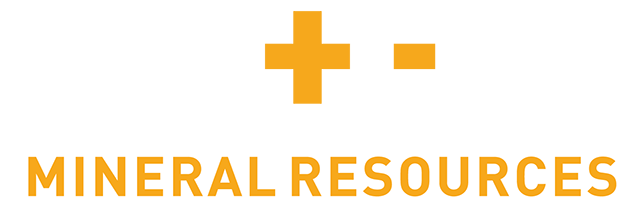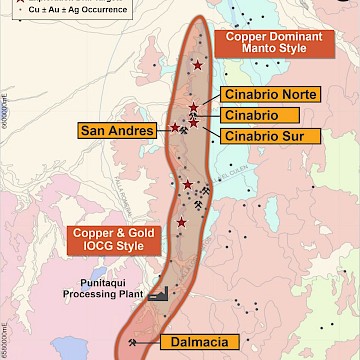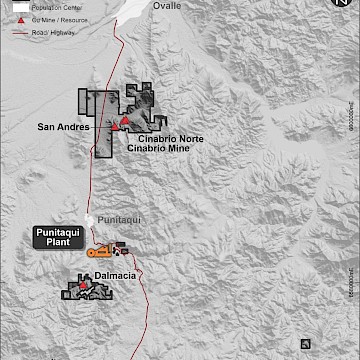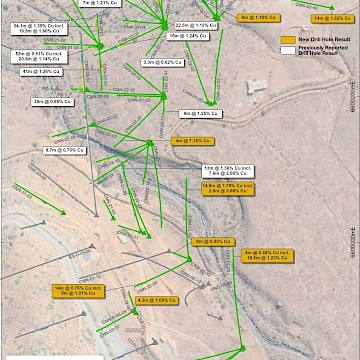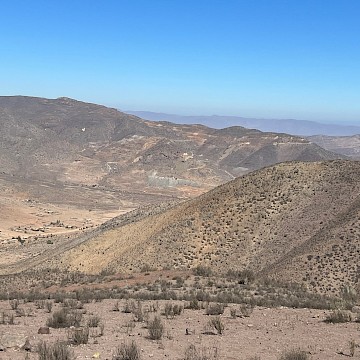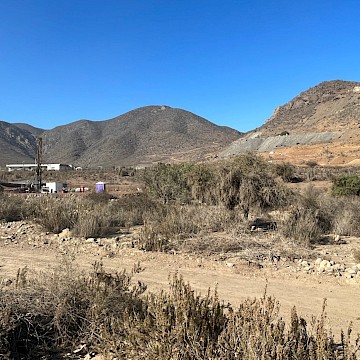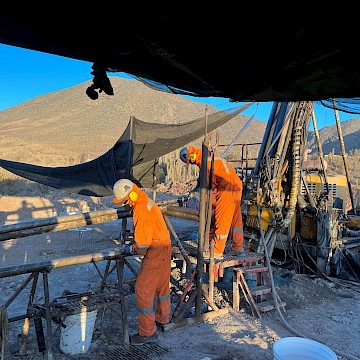Battery Mineral Resources (“BMR”) 100%-owned Punitaqui copper mine operation leverages all necessary fixed assets and infrastructure, excellent road access, ready availability of water, existing power lines, operational permits in place, and widespread mineralization. Punitaqui boasts a nine-plus year operating history.
After acquiring the assets in March 2021, BMR begin redevelopment of the operation and on May 13th, 2024, BMR announced the resumption of copper concentrate production.
The timeline from first fresh mine feed through the mill to reaching planned capacity is expected to require approximately nine months, reaching a run rate of ~90,000 tonnes per month. BMR expects that the Punitaqui full annual copper production rate will be in the range of 19 million to 23 million pounds of copper in concentrate with an operating margin of $35 million to $50 million at current copper prices.
Cinabrio is the original underground mine which was the source of feed to the copper concentrating plant for over eight years and has remaining ore to be processed. The San Andres zone has existing underground access and copper mineralization up to 30 meters wide. The Dalmacia zone also has underground access and exhibits copper mineralization widths up to 50 meters. Regional targets including the Cinabrio Norte zone offer near-term “blue sky” exploration and district-scale potential for BMR.
While the Cinabrio and San Andres mines are reaching full production, BMR will continue processing mill feed from outside sources and advancing toward its newly discovered Cinabrio Norte zone, to commence production of mill feed from that zone in H2 2025.
As part of the ongoing operational readiness during 2024, BMR is executing underground infill and extensional drilling at San Andreas and Cinabrio. The drilling program is designed to further define areas that could be included in near-term mine sequencing and for grade control purposes. BMR looks forward to reporting the results of this drilling during the course of the year.
Battery Mineral Resources (“BMR”) 100%-owned Punitaqui copper mine operation leverages all necessary fixed assets and infrastructure, excellent road access, ready availability of water, existing power lines, operational permits in place, and widespread mineralization. Punitaqui boasts a nine-plus year operating history.
After acquiring the assets in March 2021, BMR begin redevelopment of the operation and on May 13th, 2024, BMR announced the resumption of copper concentrate production.
The timeline from first fresh mine feed through the mill to reaching planned capacity is expected to require approximately nine months, reaching a run rate of ~90,000 tonnes per month. BMR expects that the Punitaqui full annual copper production rate will be in the range of 19 million to 23 million pounds of copper in concentrate with an operating margin of $35 million to $50 million at current copper prices.
Cinabrio is the original underground mine which was the source of feed to the copper concentrating plant for over eight years and has remaining ore to be processed. The San Andres zone has existing underground access and copper mineralization up to 30 meters wide. The Dalmacia zone also has underground access and exhibits copper mineralization widths up to 50 meters. Regional targets including the Cinabrio Norte zone offer near-term “blue sky” exploration and district-scale potential for BMR.
While the Cinabrio and San Andres mines are reaching full production, BMR will continue processing mill feed from outside sources and advancing toward its newly discovered Cinabrio Norte zone, to commence production of mill feed from that zone in H2 2025.
As part of the ongoing operational readiness during 2024, BMR is executing underground infill and extensional drilling at San Andreas and Cinabrio. The drilling program is designed to further define areas that could be included in near-term mine sequencing and for grade control purposes. BMR looks forward to reporting the results of this drilling during the course of the year.
Punitaqui - Cinabrio Norte
Key Facts
Overview
The Cinabrio Norte target represents a potential northern extension of the main Cinabrio mine orebody, which historically was the primary source of ore feed to the Punitaqui copper processing plant for eight-plus years. Cinabrio Norte is an underground target located 110m north of the existing Cinabrio underground workings on level 220m.
The host to mineralization at Cinabrio Norte is a package of sedimentary rocks that occurs above a sequence of andesitic volcanics, and sediments derived from those volcanics during the early stages of a marine transgression. The sedimentary package includes calcareous sandstones and conglomerates with intercalated calcareous black shales and carbon bearing fine grained sandstones.
This package averages around 15 metres thickness. Copper mineralisation including chalcopyrite and bornite was emplaced by feeder structures into the host sedimentary horizon just after sequence was deposited.
At Cinabrio Norte, the Phase 1 drill program consisted of 53 holes with a total of 13,731 meters drilled as a series of step-out holes to test the target stratigraphic unit along a 400m strike (north-south) to a depth below surface (“down-dip”) of 350m. The current drilling has outlined a significant zone of high-grade mineralization in the northern portion of the target zone which remains open at depth.
Once permitting and detailed mine design are completed, the Cinabrio Norte zone could be accessed for mining of copper ore by completing minimal amounts of underground development owing to Cinabrio Norte’s proximity to Cinabrio - only ~110m north of the 220m level in the Cinabrio mine. The Cinabrio Norte zone remains open at depth, which BMR plans to investigate via underground drilling once access has been established.
Exploration History
From 2007 – 2010, Tamaya Resources Limited, undertook a feasibility study and constructed a plant and commenced mining for a short time. Tamaya Resources targeted Cinabrio Norte with a very limited shallow drilling effort in 2008. In 2010, Glencore International Plc acquired the project, finished allocating needed capital, including upgrading plant and the underground development, then resumed operations at Cinabrio. Glencore then sold the project, in late 2018, to Xiana Mining. In 2018, Xiana Mining Inc. increased exploration efforts and initial development of the San Andres target. In 2020, Xiana completed a limited follow-up drill program at Cinabrio Norte. Historic hole CNS-20-01 drilled was drilled completely within the target stratigraphic unit resulting in multiple mineralized intercepts and, most importantly, confirmed the presence of the target unit for over 200m of strike length with anomalous copper sulphide mineralization. The target stratigraphic unit has been mapped along a north-south strike from the Cinabrio mine for 400m.
Geology & Mineralization
Cinabrio Norte is an Iron Oxide Copper Gold (IOCG) type manto deposit.
Mineralization at Cinabrio Norte has a continuous strike length of about 400m, is up to 30m thick and has been drill traced to a depth of around 350m. The mineralization is predominantly chalcopyrite with minor bornite and pyrite, dips steeply to the east and is occasionally locally faulted with small offsets.
The regional geology of Jurassic to lower Cretaceous age consists of a sequence of volcanic rocks (lavas, conglomerates and andesitic breccias) with marine sediment collations (shales, fossiliferous limestones and thin layers of sandstones). This sequence is affected by a granitic intrusive (diorites, granodiorites) of Upper Cretaceous age.
The manto mineralization is hosted by a regionally extensive marine sedimentary rock unit within an andesitic volcanic sequence. The sedimentary rock unit is comprised of dark coloured shales, volcanoclastic sandstones, volcanoclastic sedimentary breccias and conglomerates and fossiliferous limestones.
The structural framework of the district is represented by stress and compression forces, which is reflected in north-south, northwest, and east-west tectonic orientations. The structural fabric of the regional and district character controls the location of copper mineralization. The mineralized sedimentary unit is deformed and rotated by extensional faulting resulting in multiple structural repetitions of the mineralized sedimentary unit exposed at surface. The stratigraphy has been consistently rotated to the east resulting in a north-south striking and east dipping sequence.
Mineralization is variable and believed to be controlled by mineralizing fluids focused along structures within the footwall rocks. Syngenetic pyrite is a common constituent of the sedimentary unit.
Hanging wall alteration is sometimes absent but can reach up to 30 metres thick above the mineralized sequence. There are three types of hanging wall alteration which is sometimes pervasive in the sedimentary sequence.
• Silicification and sericite alteration
• Silicification with potassic alteration including epidote and specularite
• Silicification and sericite alteration with strong tourmaline alteration
In the feeder/stringer zones in the basal andesitic sequence, copper mineralization is comprised mostly of bornite associated with potassic alteration, silicification and occasional epidote. These feeder structures appear to be part of a structural network that also caused the initial depressions that were filled with the chemically favourable host sequence. They were later reactivated during compression that forced metal bearing fluids into the sequence along these structures.
Current BMR Exploration
At Cinabrio Norte, the Phase 1 drill program consisted of 53 holes with a total of 13,731 meters drilled as a series of step-out holes to test the target stratigraphic unit along a 400m strike (north-south) to a depth below surface (“down-dip”) of 350m. The current drilling has outlined a significant zone of high-grade mineralization in the northern portion of the target zone which remains open at depth. Once permitting and detailed mine design are completed, the Cinabrio Norte zone could be accessed for mining of copper ore by completing minimal amounts of underground development owing to Cinabrio Norte’s proximity to Cinabrio - only ~110m north of the 220m level in the Cinabrio mine. The Cinabrio Norte zone remains open at depth, which BMR plans to investigate via underground drilling once access has been established.
